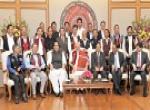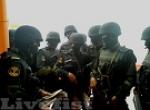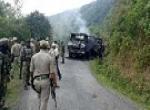Violence in Bodo areas is not a simple story of communal conflict between Bodos and non-Bodos, but is a complex issue with socio-cultural, economic, political and security dimensions. Clashes have erupted from time-to-time1 in the area, but the situation this time has reached a state where the number of killings has crossed 90. There is a displacement of about 400,000 people and its echo has been felt in other parts of India in terms of reverse flow of Northeasterners, triggered by rumours of reprisals. What factors were responsible for the present situation? Who were the actors involved? What were the major points of friction? What is the way ahead?
Land, language and livelihood have been the major elements of Bodos’ grievances that caused the community to agitate. Desire for political power came later, although the aspiration was basically to realise their core socio-economic demands. The Bodo movement in its long history “has had several forms moving gradually towards the demand for a separate state” and even a sovereign “Bodoland”. The entire movement can be broadly divided into six phases: Colonial, 1947-67, 1967-87, 1987-1993, 1993-2003 and post-2003. In each phase, the Bodos gradually advanced their socio-economic and political aspirations, but not without facing proportionate challenges in the form of resistance from other competing groups in the area, or lethargy of the state or even division within its own community. From the mid-1980s armed component to the movement took shape. Militant groups like Bodo Liberation Tigers (BLT) and National Democratic Front of Bodoland (NDFB) came to the fore. Since the 1993 signing of BAC Accord and later 2003 BTC Accord, there were concerted efforts made by the Bodos to “prove right of the autochthonous over the land” what they called “Bodoland”. They first turned to “illegal Bangladeshi immigrants” and then to Adivasis. The resultant violence and counter-violence led to large-scale killings and displacement.
To take a snapshot of present cycle of violence, the events leading to July riots was triggered by a 24-hour bandh called by All Bodoland Minority Students’ Union (ABMSU) on 29 May 2012 to protest against the alleged removal of a signboard by cadres of the ex-Bodo Liberation Tigers (BLT) from a piece of land in the Badlangmari area that had been allocated for a mosque. The bandh turned violent injuring 13 persons. The momentum of violence, however, started with the killing of two members of All Bodoland Minority Students Union (ABMSU) allegedly by Bodo gunmen at Anthihara in Kokrajhar on 06 July 2012 and on 19 July, two more people were killed in Magurmari in Kokrajhar. In retaliation, on 20 July, four former BLT cadres were killed. Violence intensified since then and went out of proportion for the local police to be able to control. It subsided only when the Army was called in.
The challenge to crafting a way ahead is can the grievances of Bodos – safeguarding their culture and improving their economic conditions – be met without a separate state of Bodoland and without compromising the interests of other ethno-religious groups living in the so called Bodo areas? The answer lies in looking at the issue in a comprehensive, rather than segmented manner. The following six broad measures can be considered:
Timely Action: Analyzing all previous incidents of violence in the Bodo areas, it is clear that as and when the security apparatus missed taking note of symptoms of unrest and failed to take appropriate proactive action, the situation got out of control. The state police and Intelligence should have woken up by March 2012 itself when Bodos started commemorating 25 years of their “struggle”. Similar symbolisms and assertions were bound to be displayed by non-Bodo groups, especially Muslims and Adivasis. The manifestation of such assertions by competing groups was always through violence. This should be understood. Signs of imminent clashes were simmering since May, but were not taken seriously by the government. Nipping the problem at the bud would have averted indiscriminate violence and resulting killings and displacement.
Political Settlement: There is no point in going for a fresh accord. The failure of Bodo Autonomous Council (BAC) of 1993 and Bodo Territorial Council (BTC) of 2003 clearly shows the problem was more with the implementation and less with the provisions per se. It is vital, therefore, to fix the present BTC accord without any ambiguities and implement it in full. It was the ambiguities in the previous two Accords that led to lot of misunderstandings, opportunistic interpretations and confusions. Yet full and timely implementation would have averted many issues. The future amendment and implementation of the Accord is such that the provisions should satisfy both Bodos and non-Bodos in unequivocal terms. It should be realised that any success of the Accord lies also in cooperation between Bodos and non-Bodos.
Armed Groups: Armed groups representing Bodos and non-Bodos have to be tackled through appropriate means, either through political or military means or a mix of both. As long as they remain armed and active, insecurity and the consequent trust deficit would linger on. It would not suffice to prevail only on those groups that have not entered into ceasefire, but on all groups that have access to weapons and are motivated to kill.
Reconciliation: There is a significant gap between the present ground reality in the Bodo areas and the romance of Bodoland. It is important to bridge this gap. The political leadership should rise to the occasion in convincing the respective communities to see the things as they are and look ahead, instead of exploiting the situation to gain electoral mileage. Appropriate confidence-building measures and reconciliation among the concerned communities – Bodos, Mulsims, and Adivasis – are crucial.
Illegal Migration: It is also important to find a lasting solution to the issue of illegal immigration from Bangladesh. Despite the enormity of the issue, the response in stemming the flow of migrants from neighbouring Bangladesh has been grossly inadequate. The entire stretch of 4,096-km India-Bangladesh border is heavily populated, making monitoring extremely difficult. Fencing has to a large extent been acting as an obstacle, but only 2,760.12 km have been fenced so far.2 The remaining stretch should be fenced at the earliest, complimented with floodlights and hi-tech surveillance devices. Most importantly, existing border has to be demarcated at the earliest to make them free of ‘enclaves’ and ‘adverse positions’; much of the activities take place in these undemarcated areas. Although the Border Security Force (BSF), in charge of policing the border, has been doing its job creditably, the force levels are not sufficient to monitor the long and difficult border. Apart from raising new battalions, it is important not to divert the BSF for duties other than border management. They also have to be equipped legally to handle situations at borders that include not only illegal migration, but also smuggling, drug-trafficking, counterfeit currency, and militant movements. Apart from creating physical hurdles, it is also important to discourage illegal migrants through suitable deterrent legislation. Till recently, illegal migrants in Assam were handled by Illegal Migration (Determination by Tribunals) Act, 1983, that was held as unconstitutional by the Supreme Court in 2005 as it was “coming to the advantage of such illegal migrants as any proceedings initiated against them almost entirely ends in their favour, enables them to have a document having official sanctity to the effect that they are not illegal migrants.”3 An exclusive refugee/migration law is long pending. It is also vital to hasten the present plan of issuing multi-purpose identity cards, at least to curb further illegal migration. At some pockets, issue of temporary work permits can be considered so that Bangladeshis can come, work and go back. At the macro level, India should help in the overall economic development and prosperity of Bangladesh so that its citizens need not to go elsewhere for their livelihood.
Refugee Camps: Relief camps housing internally displaced requires due attention. All three broad categories of communities – Bodos, Muslims, Adivasis – are housed in various camps. Some of the camps have been in existence since 1993, as inmates could not return to their homes fearing violence. Because of overcrowding there is persistent lack of food, water, accommodation, medical attention, and sanitation. These concerns should be addressed urgently. Apart from making the living conditions of the internally displaced in relief camps better, the government should make sure that the displaced are rehabilitated at the earliest. Else relief camps would turn into breeding grounds for new militants.
Endnotes
- The major incidents of inter-group violence in Bodo areas include between Bodos and Muslims in October 1993, July 1994 and August 2008; between Bodos and Santhals in May 1996 and May 1998.
- Ministry of Home Affairs, Government of India, Annual Report 2011-12, pp. 46-47.
- “IMDT Act is the biggest barrier to deportation, says Supreme Court,” The Hindu, 14 July 2005.
Published Date: 1st September 2012









Post new comment